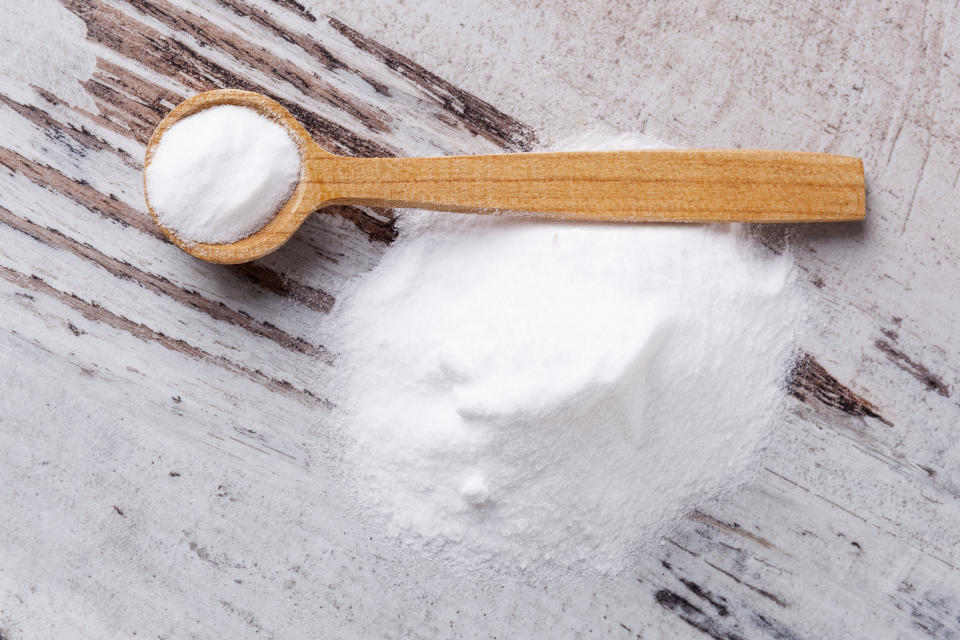Getting Rid of Mystery Stains in Your Toilet Bowl Is Easier Thank You Think — Here's How
Eew. Sometimes no matter how hard you scrub, those pesky rings and stains stuck to the inside of your toilet bowl just won’t budge. Thankfully, there’s no need to waste time and energy scrubbing away. With a few store-bought products and around-the-house staples, you can get the inside of your porcelain throne gleaming — no elbow grease required!
What causes stains in my toilet bowl?
Sure, there are the obvious answers to that question, but surprisingly those aren't the only causes for your toilet bowl stains.
The four most common stains found inside your toilet bowl are made of mineral, rust, copper and mold. The color of the stain can help tell you the cause:
White, yellow or brown rings
If you have hard water (which contains a high amount of dissolved minerals like calcium, limescale and magnesium), it can leave behind chalk-like white, yellow or brown rings that often stay put even when scrubbed with a toilet brush or wand.
Deep orange-to-red stains
These rust-colored markings are from — you guessed it — rust. The likely reason? Deteriorating pipes, and unfortunately, their deep orange-to-red hue can permanently tint your white porcelain if not treated properly.
Blue or green stains
This signifies copper stains which can be caused by copper pipe corrosion or by a high amount of copper in your water.
Black and green spots
The likely culprit: Mold. These unsightly spots give off a distinct musty odor. Mold inside of a toilet can be caused by a lack of regular cleaning or humidity trapped in your bathroom. The stains must be addressed promptly so their spores don’t continue to spread and wreak havoc in your bathroom. (Finding increasing amounts of mold in your toilet could be a warning sign of diabetes. Click through to learn more about the connection between mold in the toilet bowl and diabetes.)
How to remove newer toilet bowl stains

If you're just noticing stains in your toilet bowl, getting rid of them is as easy as reaching into your pantry, according to Marina Lawrence, owner and founder of the residential and commercial Pennsylvania-based cleaning company Life Maid Easy. That's because the most powerful pantry staple that’s perfect for cleaning new brown stains, blue stains, yellow stains and orange stains from a toilet bowl is baking soda, Its gently abrasive particles help shine the inside of the bowl and remove stuck-on grime, while also neutralizing odors to help rid the bowl of any unpleasant smells.
What’s more? Adding in a little white vinegar creates a reaction that causes the mixture to bubble up and eat away at dirt and grime.
To start, pour 1 cup of baking soda into the toilet, then add 1½ cups of white vinegar. Let the mixture bubble up for 30 seconds, then flush for a squeaky-clean bowl. For deeper-set stains, let the mixture sit in the bowl for up to a few hours, then flush.
This YouTube video shows the fun, fizzing action!
How to remove set-in toilet bowl stains
Once stains have been sitting for a while, they become that much harder to remove, says Lawrence. "We start the process by first draining the toilet bowl so the solutions that we use better absorb into the stains.”
Step 1. To drain the toilet, turn the metal shut-off valve (usually located on the wall behind the toilet) clockwise to shut off the water supply, then use a plunger to drain the hole in the bottom of the bowl until most (if not all) of the water drains out of the toilet.
Step 2. Reach for a professional strength acid gel cleaner like Zep Acidic Toilet Bowl Cleaner (Buy from Home Depot, $5.98). The gel is often strong enough to cut through even the toughest of stains. Pour it all over the inside surface of the toilet bowl, let sit for 5 to 10 minutes, then use a toilet brush to scrub it off.
Step 3. Notice stains still lingering in the bowl? Scrub them with a handled pumice stone (Buy from Walmart, $8.30). Simply wet the stone in the sink, then use light pressure and circular motions to soften the stains. “The stone is safe on the porcelain surface and its texture gently buffs away the tough buildup,” Lawrence says.
Step 4. Once you're done cleaning, turn the valve counterclockwise to turn the water supply back on, let the tank fill with water, then flush as normal
How to prevent stains in my toilet bowl?
“To prevent these types of buildups, we recommend homeowners clean their toilets at least once per week, especially if you have a newer toilet,” notes Lawrence.
Don't have time to clean it every week? No worries! Simply pour any toilet bowl cleaner into the bowl, swish it around for 30 seconds with a toilet brush and give it a flush for a quick fix between deeper cleanings. This regular maintenance prevents stubborn deposits from building up, assures Lawrence, so you won’t have to spend a ton of time or energy during your next cleaning,

